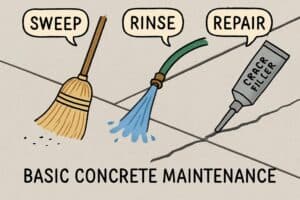Key Takeaways
- Regular cleaning and sealing guard concrete from harmful elements.
- Immediate crack repair helps prevent more severe structural damage.
- Effective drainage and the avoidance of potent chemicals are crucial for concrete longevity.
Concrete is one of the most reliable and adaptable materials for driveways, patios, and other outdoor structures. Despite its durability, even the best-installed concrete can suffer from wear and damage without ongoing attention. By incorporating simple maintenance habits, property owners can significantly extend the lifespan of their surfaces while minimizing the need for costly repairs or concrete remedial works. Such proactive steps don’t just preserve concrete strength—they maintain the integrity and visual appeal of your entire environment.
Learning how to safeguard concrete from environmental threats, chemical exposure, and structural stress is essential. Neglected concrete is far more likely to develop cracks, surface erosion, and water-related damage. Early intervention and informed maintenance are crucial to preventing these issues and avoiding the high costs often associated with major repairs or replacements.
Regular Cleaning
Keeping concrete surfaces free from debris and stains is one of the simplest yet most effective maintenance steps. Dirt, leaves, and other organic material can trap moisture, leading to staining and gradual surface breakdown. Sweep or blow away debris regularly, and use a hose or pressure washer to clean large or heavily used areas. For stubborn marks, apply a gentle concrete cleaner or a pH-neutral detergent. Steer clear of anything highly acidic, as these substances can accelerate surface deterioration over time.
Sealing Concrete
Applying a quality sealer to your concrete creates a robust barrier against water, oil, and chemicals. According to Angi, sealants help prevent porous surfaces from absorbing moisture, which can cause freeze-thaw damage in cold climates and reduce susceptibility to unsightly stains or corrosion. Experts recommend resealing every two to three years, depending on climate, traffic, and application method. Consistent sealing is part of a broader strategy for maintaining attractive, resilient concrete surfaces.
Addressing Cracks Promptly
Small cracks often start as minor cosmetic flaws, but they can signal more significant foundational problems if left unaddressed. Unchecked cracks permit moisture and plant roots to penetrate deeper, which can quickly expand into larger fractures. Conduct visual inspections several times each year—especially after severe weather. Patch small cracks with specialized concrete fillers or patching products to prevent further spread and avoid complex repairs in the future.
Managing Drainage
Water is a significant contributor to concrete damage. Poor drainage promotes pooling, which can erode and weaken slabs. Ensure all gutters, downspouts, and drains channel water away from walkways and driveways. If puddles form on the surface, adjust the concrete’s slope or consider installing a French drain or surface grates to improve runoff. Addressing drainage concerns quickly can avert significant problems—and is often more affordable than tackling large repairs down the road.

Avoiding Harsh Chemicals
Many commercial and household chemicals can be damaging to concrete, especially de-icing salts often used in winter. These salts infiltrate the surface, promoting cracking or spalling. To enhance traction on walkways, use sand or cat litter instead. Clean spills promptly using gentle, pH-neutral solutions. Avoid products labeled as acidic or formulated for industrial strength without confirmation that they are concrete-safe. For more information, the Bob Vila guide to cleaning concrete offers expert advice on product selection and cleaning technique. Regular upkeep not only preserves the appearance of your concrete but also extends its lifespan. By taking a proactive approach, you can prevent costly repairs and maintain a safer, more attractive surface.
Protecting Against Heavy Loads
Concrete is strong, but constant heavy loads—such as large vehicles or equipment parked in the same spot—can cause sagging, cracking, or settlement. Place significant weight only on concrete surfaces engineered for this level of use. If heavy loads are unavoidable (for example, during home projects), use rubber mats or load distribution plates to minimize direct force and distribute stress more evenly. Regularly check areas that support vehicles or machinery for early warning signs of stress or shifting, and address issues promptly.
Seasonal Maintenance
Different climates demand different maintenance routines. In winter, repeatedly remove snow with plastic or rubber-edged tools rather than metal blades, which can chip and gouge the surface. Avoid salt in favor of grit or sand. In hot summers, monitor for surface cracking caused by expansion and contraction, and replenish sealant if needed after periods of intense sun. Adapting these routines seasonally provides year-round protection and reduces the likelihood of surprise damage when the weather shifts.
Routine maintenance is easier and less costly than attempting repairs on severely damaged concrete.






